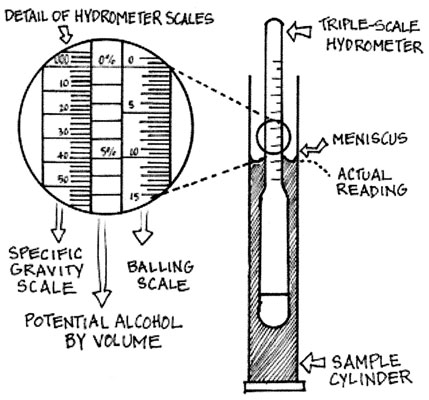Making and bottling a batch of beer, like building Rome, can’t be done in a day. On the other hand, it doesn’t take a heck of a lot longer than a day, either. You need to set aside two days, about a week apart, for the job. Allow three hours each day to set up, brew (or bottle), and clean up. Patience is a virtue; good homebrew is its own reward.
Okay, now it’s time to make beer. Be sure to have all your equipment and ingredients on hand before starting.
Fill your brew pot two-thirds full of cool water and place it on the stove, with the burner set on medium-high.
Use the largest burner available.
The quantity of water used in this step isn’t important, but you should boil as much as possible. Don’t worry — you’ll make up the difference to 5 gallons by adding more water to the fermenter later (in Step 12).
Heat the thick, syrupy malt extract to make it less viscous and easier to scoop out of the can (or squeeze out of the bag).
You can heat it by immersing it in hot water for about 5 minutes.
Open the can or bag, scrape all the extract into the brew pot, and use your virgin brew spoon to give the mix a vigorous stir.
Set a timer or note the time when you poured extract into the brew pot. Boil uncovered for 1 hour, stirring regularly and keeping the brew pot at a slow, rolling boil.
Add your hops to the brew pot according to your recipe.
Hops are typically added to the brew pot in small increments like an ounce or a half an ounce at a time. They’re also typically added at quarter-hour increments of time like 15 minutes or 30 minutes.
While the extract is boiling, sanitize the equipment you need for fermentation.
The items you need to sanitize are
Primary fermenter and lid
Disassembled airlock or bubbler
Rubber stopper
Clean coffee cup or small bowl (for the yeast)
Triple-scale hydrometer (not the cylinder)
Place the fermenter in the utility tub (or large sink) and begin drawing cold water into the fermenter. Add cleansing/sanitizing chemicals, according to package directions, or 1 ounce of unscented household bleach per gallon of water. Allow water to fill the fermenter; then shut off the water. Immerse the remaining equipment in the fermenter, including the fermenter lid (you’ll have to force it in a bit).
After half an hour has elapsed, remove and rinse the various pieces of sanitized equipment.
When 1 hour has elapsed since you poured in the extract, turn off the burner and now place the lid on the brew pot.
Cool the wort (after it’s mixed with water, the boiled extract is transformed into wort).
While the wort is cooling, fill your sanitized cup or bowl with lukewarm water (approximately 80 degrees Fahrenheit, 27 degrees Celsius), tear open the yeast packet, and sprinkle the yeast into the water.
To avoid contamination, don’t stir. Allow the mixture to stand for at least 10 minutes, covered with plastic wrap to ensure against airborne contamination. This process, called proofing, is a gentle wake-up call for the dormant yeast and prepares it for fermentation.
When the brew pot is cool to the touch, carefully pour the cooled wort into the sanitized fermenter.
Make sure the spigot is in the closed position (you don’t even want to think about the consequences of leaving it open).
Top up the fermenter to the 5-gallon line with cold bottled water (or tap water, if yours is of acceptable quality).
Take a hydrometer reading (optional).

Pour the yeast into the cooled wort to start the fermentation process.
Brewers call this step pitching the yeast. Gently pour the yeast in a wide circle to disperse it well.
Close the fermenter with its lid, leaving the airlock or bubbler out, and place the fermenter in a cool, dark location, such as a basement, crawl space, or closet.
When the fermenter is in place, attach the rubber stopper to the airlock, fill it halfway with water, and snap on the airlock cap; then position the airlock (bubbler) securely into the hole in the fermenter lid.
Wait seven or eight days.
This step is the hardest, especially for first-timers.

